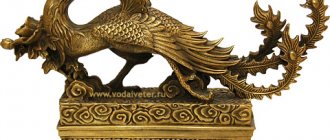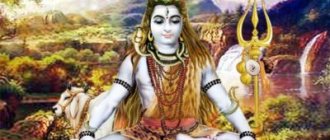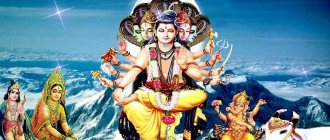Lakshmi is the goddess of wealth, prosperity, well-being in India, the wife of Vishnu. We invite you to find out her birth story, names, symbols and their meaning. Mantras and hymns of Lakshmi.
Lakshmi is a multi-armed Indian goddess who personifies family well-being, good fortune, immortality, material wealth, abundance, and blessing. She is the embodiment of the creative energy of Vishnu and, concurrently, his wife. Often the goddess in images appears with a lotus - sitting, standing or holding this sacred flower in her hand. And this is not without reason, because in Hinduism the lotus symbolizes spiritual purity, bright thoughts, motherhood . Find out more about the lotus in Indian culture.
From Sanskrit Lakshmi means “happiness”, “luck” . In addition, the name Lakshmi itself can be interpreted as a lucky sign and a favorable opportunity for doing something good , since “lakṣ” is interpreted as “goal”, “understand the goal”, “perceive”.
Laxmi (Lakshmi) is also the goddess of success and love. In honor of her, memorable holidays, performances with fireworks and fun are organized in India. After all, as legend says, she seeks rest where joy reigns and laughter sounds, where everything is brightly lit. In gratitude for such a cozy environment, she generously bestows wealth, prosperity, mutual understanding and a sense of happiness.
The story of the birth of the many-armed goddess
According to one of the most common legends, the goddess of abundance, prosperity and wealth appeared sitting on a lotus flower. This is stated in the Vishnu Purana, Mahabharata and Ramayana. Allegedly, at this time the devas and asuras were churning (churning) the Ocean of Milk. During this, various herbs were thrown into the ocean waters, which, thanks to the churning, turned into 14 treasures, one of which was Lakshmi.
“Then, from the waters, shining with beauty, the goddess Sri rose, confusing her thoughts, she stood in a shining lotus, she had a lotus in her hands. Overwhelmed with joy, the great rishis glorified her with a hymn dedicated to Sri; in front (of the goddess) were the Vishvadevs and the Gandharvas sang. Before her, O brahmana, the ghritachas and hosts of apsaras danced; The Ganga and other (sacred) rivers served her with their waters for bathing. The heavenly elephants, taking golden jugs with the purest water, washed the goddess, the great Ruler of all worlds.”
(“Vishnu Purana”, chapter IX, slokas 98–101).
This is perhaps the most popular version of the birth of the goddess Lakshmi. But, there are other mythological assumptions. According to one of them, Sri Lakshmi is the child of the sage Bhrigu and his wife Khyati. And this is stated in the Vishnu Purana:
“In the beginning, Sri was born from Bhrigu and Khyati, and (then) was born again from the ocean, when the gods and Danavas were diligently churning the nectar of immortality. Just as the Master of the world, the king of the gods Janardana, is born (in various forms) as an avatar, so is his girlfriend Sri. When Hari was the son of Aditi, she was born from a lotus; when he was (born) as Rama of the Bhrigu family, she was Dharani. He was born as Raghava, she as Sita; when he was (born as) Krishna, she was (born as) Rukmini, and in other avatars of Vishnu she was his friend. Whatever form Vishnu took, whether divine or human, she also took the form corresponding to him.”
(Vishnu Purana, Book I, Chapter IX).
There is also an opinion that the goddess accompanies her husband Vishnu everywhere and in all avatars. There is even an assumption that it appeared from a lotus flower located above his head.
In the Mahabharata you can find a mention that Lakshmi is introduced as Draupadi, the wife of the Pandava brothers. They are the embodiment of gods who were born on earth from Indra, Vayu, Dharma, Ashvins. The following lines confirm this:
“And a particle of (the goddess) Sri, for the sake of satisfying (Narayana), incarnated on earth in the family of Drupada in the form of his impeccable daughter.”
(Mahabharata, book I, Adiparva, chapter 61).
Durga is the incarnation of several goddesses
Gods in Hinduism can reincarnate and have several appearances. They appear on earth, taking on different divine guises. Goddess Durga also does this. She has many faces: Kali, Bhavani, Ambika, Lalita, Gauri, Kandalini, Java, Rajeswari, Lakshmi. Durga also appears in her own form, which has 9 forms (deities). She combines the powers of several goddesses. Each such goddess has her own Hindu calendar holiday. On such a day, people say special prayers. They sing songs in praise of the goddess.
Numerous names of the Goddess
Lakshmi has many names, each of which has a specific meaning. Her sacred name is the name Sri, translated from Sanskrit as “prosperity”, “happiness”. In the Vishnu Purana, various shlokas and puranas of ancient scriptures, the goddess is called exactly that and is given the role of Mother of the world.
The Skanda Purana, which describes the life path of Kartikeya (the son of Shiva and Parvati), lists the names of Lakshmi. Surprisingly, in it you can find references to 1008 names of the goddess! They are also called Lashkmi-sahasranama. They are read on Fridays early in the morning. The names of the Indian goddess are also described in the Brahma Purana.
Here are just some of the names of Lakshmi (the most traditional) and their meanings:
- Srija - Born in prosperity;
- Kamala, Padmasundari - Beautiful as a lotus;
- Padma - Lotus-like;
- Padmapriya - Loving lotuses;
- Padmahasta - Holding a lotus;
- Padmamaladhara - Wearing a lotus garland;
- Padmakshi - With beautiful eyes like a lotus;
- Padmamukhi - With a beautiful face like a lotus;
- Jagadishwari - Mother of the world;
- Ulkavahini - Moving on an owl;
- Vishnupriya - Vishnu's Beloved
Other, not so popular names of Lakshmi: Aishwarya, Mohini, Lalima, Indira, Nandika, Nandini, Sridevi, Madhavi, Shriya, Tripura, Malti, Devi, Savitri, Aruna, Akhila, Avashya, Sita, Sharanya, Anumati, Durga, Rujula, Sujata, Jalaja, Bala, Kriyalakshmi, Kamalika and many others.
Temples
Worshipers of the goddess can be found not only in India, but throughout the world. Several temples were built in her honor where believers say their prayers. For example, in the temples of Vishnu and Narayana (this is the name of one of the incarnations of Vishnu from cosmic reality).
There are temple complexes built in honor of Lakshmi at Birla Mandir (Delhi), Varadaraja (Kanchi), Jagannath (Puri), Ranganatha (Srirangam). There are places of worship in big cities, such as: Mahalakshmi (Mumbai), Ashtalakshmi (Chennai), Ashtalakshmi (Hyderabad). The spoken prayers and requests will sound in a special way.
Goddess symbols and their meaning
“I pay respects to the mother of all beings, who emerged from the lotus Sri - her eyes are like lotuses blooming after sleep - she clung to Vishnu’s chest! You are a wonderful power, you are a sacrifice to the gods and a sacrifice to the pitaras, you are the mother, the purifier of the worlds, you are the morning and evening twilight and night, power, well-being, sacrifice, faith, Saraswati!
"Vishnu Purana", book. I, ch. IX, slokas 115–116.
These words describe the Goddess in the Vishnu Purana. However, this is only part of what is said about the lotus-eyed goddess in the writings. They like to depict her in different guises, with different objects and different blessing gestures (the so-called Lakshmi mudra), which have a deep spiritual meaning.
The Indian goddess with many arms is most often shown sitting on a lotus, which is a symbol of motherhood and spiritual purity. Incredibly beautiful, she fascinates, makes you look at every symbol depicted with her.
You can find a variety of pictures in which Lakshmi appears in various images. The goddess of prosperity can be depicted with a different number of hands. And this is not without reason. If she has eight hands, then in them she holds a gada (staff), dhanus (bow), shankha (shell), arrow, ankus (goad), wooden pestle, chakra (wheel), padma (lotus).
If Lakshmi has four arms, then there may be several options:
- Padma (lotus), shankha (shell), gada (rod), chakra (wheel).
- Padma (lotus), lotus, nectar vessel, mahalunga (lemon-like fruit).
- Padma (lotus), sankha (shell), bilva fruit (wooden apple), ambrosia vessel.
- In the upper hands there is a lotus, and from the lower hands gold coins are pouring, or coins are pouring from only one, and the fingers of the other are folded in a blessing gesture.
Lakshmi may also . In this case, she holds a lotus in one hand and a conch shell in the other. With Vishnu, she most often has exactly two hands. In one of them she has a lotus, in the other she has srifala (coconut) or lotuses in each hand. She sits on the snake Ananta, the left thigh of Vishnu or the eagle. Sometimes you can find images showing a goddess with six arms .
It can also be noted that the Indian goddess, or more precisely, the color of her skin, can be described in different ways. It can be pink, golden yellow, white, dark. If Lakshmi is the color of a thundercloud, then this directly indicates that she is the wife of Vishnu, the dark-faced God. The color pink represents Lakshmi's essence as compassion for all living beings, as she is the Mother of all things .
Goddess Lakshmi is often dressed in golden robes, standing or sitting on a blooming lotus flower. Sometimes I come across pictures in which elephants are waist-deep in water next to her. These are Gaji Lakshmi, symbolizing the splendor and glory of the great goddess . By the way, the Lakshmi lotus may be at different stages of opening. And this is not just like that. He personifies beings at different stages of development of consciousness .
So, Lakshmi is the goddess of prosperity and the goddess of wealth, a symbol of love and motherhood, grace and beauty. She is the embodiment of spiritual purity, immortality, good luck, happy destiny. And each Lakshmi symbol has a deep meaning.
Yantra
The Sri Yantra is considered universal; it depicts the goddess Lakshmi in the form of a complex structure consisting of geometric shapes (a symbol of the cosmic essence of the universe). Such a yantra is mentioned in the Atharva Veda as a ritual one: 9 triangles intersect in the picture.
Also in the yantra you can see a protective square, which has gates in the cardinal directions (Bhupura). The energy of shakti dwells in it throughout the entire existence of the world. There are also two circles with lotuses inside (each with 16 and 8 petals), inside the circles there are five rings with 43 triangles. The center of the yantra is decorated with the Bindu point, personifying “non-existence” and higher consciousness, the so-called “center of the Universe”.
This design combines the two energies of Shiva and Shakti. In this case, the masculine principle manifests itself in triangles directed upward. And the feminine principle looks like triangles looking down. The Yantra creates a beneficial effect for the person looking at it.
Ashtalakshmi
Ashtalakshmi (Ashta-Lakshmi) is translated from Sanskrit as “eight Lakshmi” . When this word is mentioned, they mean the secondary manifestations of the Indian goddess, which are represented by a group of female goddesses. These Indian deities are also called Lakshmi avatars. All of them symbolize various forms of well-being: offspring, power, prosperity, strength, knowledge, health . In honor of Ashtalakshmi, figures are created, decorated thematically, and hymns and printed images are dedicated to them.
Ashtalakshmi
Avatars of Lakshmi:
- Adi-Lakshmi (from Sanskrit means great Lakshmi) - this hypostasis is the daughter of the great sage Bhrigu. She is depicted with four arms. The lower hands show varada mudra (mercy, sincerity, compassion) and abhaya mudra (confidence, protection, fearlessness, calmness).
- Dhana-Lakshmi (Lakshmi, the giver of wealth) - symbolizes material wealth. In her six hands are a shankha, an akra, a bow and arrow, a jug of amrita, and a lotus. One hand demonstrates Abhaya mudra. She stands in red robes under a rain of sparkling gold coins.
- Dhanya-Lakshmi (Lakshmi of agriculture) is a symbol of fertility and patronizes agriculture. Six of her eight hands hold rice shoots, two lotuses, bananas, sugar cane, a mace, and two hands show abhaya mudra and varada mudra. This hypostasis of Lakshmi is dressed in green clothes.
- Gaja-Lakshmi (Lakshmi surrounded by elephants) - demonstrates power, patronizes animal husbandry. In two hands there are two lotuses, and two more hands show varada mudra and abhaya mudra. On both sides there are elephants who hold jugs of water in their trunks and water the goddess with it. According to legend, it was Gaja-Lakshmi who was able to return the wealth lost by Indra.
- Santana-Lakshmi (Lakshmi of offspring) - patronizes, protects families, helps to have offspring (primarily boys). In the image he has six arms. In two hands she holds jugs with amrita, in two more - a shield and a sword. With one hand she shows abhaya mudra, and with the other she hugs the boy sitting on her lap and holding a lotus in his hands.
- Vira-Lakshmi (courageous or valiant Lakshmi) - personifies courage, valor. It gives people strength and courage so that they can overcome difficult life obstacles. She is depicted in red robes and with eight arms. Holds a bow, arrow, shankha, chakra, sword or trident, Vedas (written on palm leaves). The two hands are folded in the varada mudra and abhaya mudra gestures.
- Jaya-Lakshmi (Lakshmi of success) - gives success in business, good luck and victory. Has eight arms. They hold a shield, sword, chakra, lotus, pasha, shankha, show varada mudra and abhaya mudra.
- Vidya-Lakshmi (Lakshmi of wisdom) - personifies knowledge and wisdom. First of all, he patronizes schoolchildren and students. Her eight hands hold a jug with amrita, shankha, bow, chakra, and demonstrate abhaya mudra and varada mudra. Traditionally dressed in yellow.
The cult of Ashtalakshmi originated in the 70s of the last century. This happened thanks to Vidvan Mukur Srinivasa Varada, a theologian of Sri Vaishnavism. He dedicated a hymn to Ashtalakshmi called "Ashta Lakshmi Strotam". Today this teaching is most widespread in South India.
Features of the mantra
The Goddess is known for her unpredictable character, so before you start reading mantras, you should familiarize yourself with some rules:
- The goddess listens to the prayers of only people with pure thoughts, which means that before practice it is important to get rid of negative emotions. A relaxing bath with incense and meditation will be useful.
- You cannot make requests to Lakshmi that could harm another person.
- The goddess demands worship, love and admiration from her followers. There is no doubt about the power of Lakshmi. During spiritual practice, a person should feel sincere gratitude to the supreme deity.
Lakshmi and Vishnu: a love story
The Indian goddess of love is described as a fickle, independent and multi-faceted personality. Her peculiarity is that she is capable of being both very soft, gentle, and jealous, showing discontent and wayward character . As various myths and legends describe, Lakshmi is quite capable of leaving one ruler for another, because she is inextricably linked with the attributes of power. As long as one is in the royal place, the goddess invariably belongs to him. As soon as he loses power, the Goddess leaves him.
Despite her fickleness, Lakshmi developed a strong relationship with Vishnu . In order for his wife to always remain happy and satisfied, he constantly makes efforts. And this bears fruit - the goddess reciprocates his feelings, remaining faithful. She follows her beloved husband everywhere, living in harmony with him.
Lakshmi and Vishnu are one. They complement each other, penetrate each other, fill each other. They are the embodiment of everything that exists. Lakshmi is the source of God's power, which continuously fills him with energy. She can often be seen in images as an amazingly beautiful goddess present next to Vishnu.
The relationship between Lakshmi and his husband, the god Vishnu, as well as the place of the goddess in the Universe is spoken of in various myths and scriptures, including the Vishnu Purana:
“Vishnu is the meaning (of a word), she is its sound, Hari is guidance, she is good conduct. Vishnu is the creator, she is the creation; Hari is the Holder of the earth, she is the earth; Bhagavan is joy and Lakshmi is constant contentment. Sri is desire and Bhagavan is love, he is the sacrifice, she is the sacrificial gift; the goddess is a sacrifice of clarified butter, Janardana is a (sacrificial) cake made from ground rice... Lakshmi is a temple for women, and the Demon Destroyer Madhu is a temple for husbands; … Bhagavan is the embodied Samaveda, and the One who dwells in the lotus is the rhythm (of the verses of the Samaveda), Lakshmi is a sacrifice to the gods, and the Patron of the world Vasudeva is (sacrificial fire). Bhagavan Shauri is Shankara, and Sri is (his consort) Gauri; Keshava is the sun, O Maitreya, and She who dwells in the lotus is his light.”
And these words also perfectly reflect who Lakshmi’s husband is and who she herself is:
“Why so many words? Bhagavan Hari is (all) that among gods, animals, people and others is called a man, and Lakshmi is (all) that is called a woman. And besides them, there is nothing new.”
(Vishnu Purana, Book I, Chapter VIII).
Ancient Indian painting “Vishnu and Lakshmi”
In the tantric direction, the consort of the god Vishnu represents his potency-energy. It awakens passion, excites, gives strength. The Creator creates worlds, and his wife helps them flourish. Yes, Lakshmi acts independently, but she does it in such a way that all her activities reflect the will of her husband. Complementary union is the key to harmony.
Essentially, Lakshmi is the female manifestation of Vishnu. It reflects God-partnership, God-love. The masculine and feminine principles together form Brahman, who is called Lakshmi-Narayana. Born together with Vishnu, she maintains the beauty, harmony and prosperity of the whole world. He is everything masculine, and she is everything feminine.
If you work correctly with the energy of Lakshmi, you can attract true happiness and love into your life. This can be useful both for married people who have lost touch with their partner, and for single people who are just at the stage of searching for a soul mate.
Joy in the name of Goddess Lakshmi
The atmosphere of joy and fun is native to Lakshmi. Today, many festivals are held in India in honor of the goddess. They are always accompanied by colorful spectacles, fireworks, theatrical performances, dances and songs. All this is the element of Lakshmi.
The goddess brings happiness and success to those who are ready to have fun and give joy, because she herself loves smiles and carefree joy. A sincere and kind person, open-hearted, ready for mutual understanding and expression of positive emotions, can enlist Lakshmi’s support.
Perhaps this is the essence of Indian worldly wisdom. Despite all the hardships of Indian life, I have never met gloomy or angry people - the people of India try to maintain optimism and the inner light that helps them live.
Holidays dedicated to Lakshmi
Many holidays are dedicated to the goddess, during which she is revered. One of these is Navratri, which falls in the period September-October . It is celebrated for nine days, because according to myth, the goddess Durga fought with the demon for nine days in a row, taking the form of a buffalo. On the ninth and last day, she won. In Bengal, Durga, her two daughters (Lakshmi and Saraswati) and two sons (Kartikeya and Ganapati) are worshiped as the embodiment of wealth, knowledge, strength and intelligence respectively. In southern India, this holiday is celebrated for three nights three times. The first three nights the goddess is treated as Lakshmi, the second three as Saraswati, the third three as Kali. In Gujarat, at this time, women dance and sing, glorifying the fertility of the earth goddess Bhu-devi.
Photo from Navaratri holiday
Another holiday that is widely celebrated in India is Diwali (Deepavali). It is even called the “festival of lights” and is also dedicated to the goddess Lakshmi, who is revered with special respect these days. Lakshmi Puja is a ritual of worshiping Goddess Lakshmi. It is a very important part of Diwali. During the puja, believers invoke the deity, hoping for improvement in well-being, financial situation, love and family relationships.
For five nights (that's how long Diwali is celebrated) after Sharad Purnima on the arrival of the new moon, which occurs in October-November, people explode firecrackers, light lanterns, oil lamps, garlands, distribute sweets, and light incense. Each of the five nights is celebrated in a special way. But, in any case, during Diwali, women try to thoroughly clean their homes and decorate the thresholds with auspicious symbols and ranglis (colored patterns) . Before night falls, people decorate the house with as many lights and garlands as possible, dress up in their best clothes, have a festive dinner and exchange gifts with loved ones.
Happy Diwali
Along with Lakshmi, on these same days they also worship other “money” gods - Ganesh and Kuber. It is especially recommended to contact this trinity for those who are engaged in business or have just embarked on the path of organizing their own business. Some enterprises even prefer to create new accounting books, and many businessmen try to enter into new deals and agreements.
Diwali is celebrated throughout India, but it is most popular in its northern part, Maharashtra, Gujarat, and Tamil Nadu.
Onam is celebrated in August-September. It is celebrated on a special scale in the state of Kerala. In Punjab, this holiday is called “Baisakhi” or “Vaisakhi” - equivalent to the harvest and New Year festival. In the morning, people begin to prepare the most significant symbols of Lakshmi: gold, rice, vegetables, fruits, mirror, flowers, water.
On the festival of “Varalakshmi nombu” or “Vra-lakshmi vrata”, everyone who desires blessings turns to Lakshmi. It is celebrated most of all in the southern part of India, namely in states such as Andhra Pradesh, Karnataka, Tamil Nadu, Telingan. Those who believe ask the Indian goddess for health, children, wealth, property, food, spouse, happiness. During the special puja, 108 names of Lakshmi are chanted. In order not to upset or offend her, you should not leave this ritual before its completion.
Sitting on a tiger or lion. Holidays dedicated to Durga
Hindus depict their goddess sitting on a tiger or lion. By this they show the will, determination and strength of Durga. Sometimes Durga stands on the top of a mountain. She controls a wild beast, this is how her mastery in all qualities is manifested. The tiger is a symbol of unlimited power. The pose in which Durga stands is called Abhay Mudra.
It means that the goddess is free from fear. The Defender fearlessly confronts the forces of evil. She uses her energy to eradicate evil and protect good. Durga is depicted wearing a red sari. This is how artists show that it protects people from pain and suffering. Hindus should behave like their goddess. Her energy is divine light (jyoti), feminine creative energy.
Durga is dedicated to numerous Hindu holidays, which are celebrated several times a year. The most famous of them is Durga Puja. It is celebrated for four days in September or October. It depends on the lunar calendar. Durga Puja is a celebration of victory over evil. On this day, Hindus read prayers and sing songs praising the goddess. They decorate temples and houses, and performances about the legend of Durga are held everywhere.
Another festival dedicated to the goddess is celebrated for nine nights. It is called Navratri. On the last day, an effigy of Ravana is burned. Animals are sacrificed to Goddess Durga, for example, turtles, kids, poultry, and fish. Sometimes human blood is spilled on the altar. There are several mantras dedicated to the eight-armed goddess. By pronouncing “Om Sri Durgaya Namah”, a person eliminates physical, psychological, worldly problems. The soul becomes boundless, spiritualized and blessed.
Who does Lakshmi protect?
The many-armed goddess Lakshmi is a reliable support for those who are engaged in creativity and have connected their lives with this direction . She loves no less those who have found themselves in a profession related to the production of clothing or household items, cosmetology, finance, jewelry making, raising children, cooking, farming, and social assistance. Perhaps it is simply impossible to list all the areas of activity under the patronage of the goddess.
It is also worth remembering that Lakshmi can be both infinitely kind and merciful and angry - however, quite deservedly. She doesn't like it when people are too greedy and when, on the contrary, they waste too much money . If a person shows disrespect for food, has an unkempt appearance, there is dirt and strife with relatives in his house, conflicts at work - Lakshmi will turn away from such a person . She also does not encourage the killing of animals, poor treatment of natural resources, or the destruction of beautiful things.
Particular attention should be paid to wearing gold. If this is done incorrectly, luck, happiness and material well-being can turn away from a person. Since gold is one of the manifestations of Lakshmi and the Sun God (Surya), it must be treated with respect . You should not wear it on your ankles as a bracelet, as this part of the body is considered dirty. At the same time, the goddess does not limit the desire of both women and men to wear gold jewelry on any other parts of the body.
Lakshmi values courage, strength, the ability to withstand powerful opponents and win in the fight against them. The goddess patronizes people who are able to show determination.
The lotus-eyed goddess shows women by her own example how they should treat their spouses. They must honor their husbands as gods, remain faithful to them, always be wonderful housewives, attractive, and homemakers. At the same time, a grateful husband will surround his wife with care, attention, and give her what she wants.
Tips and tricks for beginners
If you have never used Buddhist prayers before, chanting mantras can be a little challenging. Therefore, it is better to start by listening to audio recordings.
In order for the session to give the desired result, you should properly prepare for it:
- Take a bath by adding sea salt or aromatic herbs to the water.
- Light incense in the room, then take a comfortable position (you can even lie down in bed).
- Focus on your desire.
- Now you can turn on the recording and relax, feeling how positive energy fills every cell of the body.
You need to listen to the mantra until you reach a state of pleasant fatigue.
How to earn the favor of the goddess?
In order for Lakshmi to bring good luck, prosperity, love and mutual understanding to the house, various techniques are used.
The very first thing you need is to pay special attention to the home into which you want to attract the goddess . It is better if we place a figurine of Lakshmi or at least her image in the house. Since Lakshmi is interested in financial affairs and material well-being, and she herself does not tolerate inaction, it is best to place her image in the hallway or study. This is because these parts of the house have a connection with material wealth, financial wealth, and an increase in financial wealth. also advisable to focus on the southeast direction when placing the symbolism of the goddess . The southwestern direction is also allowed as the personification of travel and help.
Modern feng shui experts say that you can put a photo on the desktop of a computer device. It should depict the goddess with those symbols that represent your most pressing needs. There are enough necessary pictures and photos on the Internet.
You should do your best to stop quarreling and not keeping promises . Lakshmi loves when people take responsibility for their actions and take initiative . Special attention should also be paid to the cleanliness of the home. It is necessary to clean it as often as possible. You can periodically light incense sticks (ideally made from lotus and other flowers).
Goddess Figurines
To further appease Lakshmi, an altar should be installed and its surface covered with a beautiful cloth embroidered with gold threads. In its center there should be a figurine or image of this deity. The altar should be decorated with gold items, fresh large flowers, and precious stones (especially red and yellow jade, lapis lazuli).
Lakshmi is compassionate and merciful. She does not tolerate cruel, aggressive, envious and vicious people. therefore, in order to earn her favor, it is important to work on your spirituality.
Lakshmi will never stay where there is anger, hatred, lies, envy, hypocrisy and violence. She is also intolerant of sexual perversions, and therefore does not encourage non-traditional sexual orientations, accompanied by unhealthy hobbies, and the trade in intimate services. She simply leaves this place and does not want to return there anymore. And behind it goes prosperity, well-being, luck and happiness. Life in peace, love, harmony - that’s what she likes. And for this she generously rewards.
What is the deity responsible for?
Lakshmi is associated with prosperity, beauty, luck, she is able to help people achieve both material and spiritual benefits, as she is the source of any wealth, all universal abundance.
She is considered a special goddess in the Hindu pantheon. Why? Because it allows people to realize 4 basic goals in life:
- Dharma - living righteously, fulfilling your destiny.
- Arthi - to achieve prosperity by realizing your natural talent.
- Kamu is physical pleasure that occurs harmoniously, without violating the laws of the Universe.
- Moksha – spiritual freedom.
Wherever the divine Lakshmi is, she spreads the energy of abundance and good luck everywhere. Hindus usually call it “Sriyam”, which means the possession of 6 graces: wealth, strength, influence, beauty, knowledge and self-denial. A person can receive any of them, if, of course, he deserves it.
In the process of glorifying the goddess, she is given the title “sati” (that is, chaste), since her thoughts are always occupied only by the Supreme Personality of Godhead and no one else.
Lakshmi deservedly received the title of an ideal wife. In many of her images, she massages Vishnu's feet, showing her love and commitment to him. She acts as the Primordial Mother. In ancient times, it was believed that she was the first before everything else, and in her womb life itself and all the other gods were born.
Lakshmi as srivatsa
The word "srivatsa" in Sanskrit means "beloved Sri". This is a curl of hair or an auspicious sign that is located on the chest of Vishnu - the beloved husband of Sri, that is, Lakshmi. This sign testifies to Vishnu's fidelity to his wife. Since Lakshmi is the goddess of wealth and prosperity, it is natural that srivatsa can bring good luck. We also have an interesting article about the Aum symbol.
Srivatsa symbol in different versions
Krishna is the eighth avatar of Vishnu. In the center of his chest is srivatsa. This symbol is also called “nandyavarta”, which translates as “curl of happiness”. It is a combination of hooks forming a Greek cross, or has the shape of a swastika.
The so-called endless knot (granthi) has been known for a long time. It was depicted on clay products 2500 thousand years BC. Buddhism later borrowed this symbol, which is believed to bring good luck.
What do we need for practice?
1.Roads made of 108 beads.
2. A beautiful large candle, such that it will last for 21 or 40 days. Or a lamp with ghee (clarified butter). You can simply put the oil in a bowl and make a wick from a regular piece of cotton pad. This turns out to be both a candle and an offering; ghee is considered a very pure, gentle, blissful energy, and such an offering always works very well.
3. I also like to seal the energy raised and pumped up in practice - into something concrete, significant and tangible. So, to charge the selected physical item. And then use it both as a portal to resources and as a kind of battery charged with the necessary energy.
For this practice I usually use a rose quartz crystal. Which I charge in practice, holding it in my right hand while reading mantras. And then I either wear it around my neck in a drawstring pouch, or keep it near me in my space.
In order to use all my internal resources, I definitely include smells in this practice. And Lakshmi loves floral scents.
I usually use jasmine, jasmine aroma oil. I put a couple of drops on my rose quartz crystal, and then when I wear it on my chest, it smells very nice and works wonderfully with my heart chakra.
Mantras, prayers and hymns praising Lakshmi
There are many prayers, stotras, hymns, slokas and mantras dedicated to the Indian goddess of wealth. The most famous Lakshmi mantra is: “ Om Hrim Shrim Lakshmi Byo Namaha .” It actually means “ Goddess Lakshmi resides within me and bestows abundance in all aspects of my existence .” But, there are a large number of other mantras with different meanings. Often people read a mantra without knowing its true purpose. But each of them has a specific purpose and effect.
The mantra “Om Lakshmi Vigan Sri Kamala Dharigan Swaha” helps those who want to find peace, fulfill their cherished desires, and improve their financial situation. For it to be as effective as possible, it should be repeated from April 13 to May 15, 108 times daily.
Audio
Sadhana Lakshmi for material well-being
This technique for achieving prosperity is called “Lakshmi Sadhana” - turning to Lakshmi. A disciple of the sage Vasishtha gave us instructions for this practice on the condition that it be performed as it was performed by the yogi master Rishi Vasishtha.
On Friday evening, he performed purification, sat in front of the image of Goddess Lakshmi on a yellow blanket and, facing east, repeated the mantra:
Om Mahalakshmae Vidmahe Vishnupriyae Dhi Mahi Tanno Lakshmi Prachodayat
or
Om Shrim Mahalakshmiye Matchmaker
Then he lit 4 lamps (candles) - a symbol of wealth, spiritual strength, success and profit. Then he repeated 21 circles (1 circle = 108 repetitions of the mantra) of a special mantra of prosperity on the rosary:
Om Hrim Kamal Vasiney Pratyaksham Hrim Phat
As a result of this practice, the disciples of the sage Rishi Vasishtha never encountered poverty or grief throughout their lives.
Tantric mantra of Goddess Lakshmi, eliminating misfortunes
oM aiM hrIM shrIM shriyai namo bhagavati mama samR^iddhau jvala jvala mAM sarva-sampadaM dehi dehi mamAlakShmIM nAshaya nAshaya huM phaT svAhA
Ohm. Aim Hrim Shrim. Worship to Sri! O Goddess, ignite the strength in me, ignite me, grant me all kinds of luck, grant me! Destroy my misfortunes, destroy them - Hum. Phat. Matchmaker!
(Anyone can repeat this mantra simply as a prayer formula without any special restrictions. But for occult use, diksha and transmission are needed, in which the guru verbally explains to the disciple the nuances of using this mantra and the special practices of purashcharana and anushthana associated with it. The one who performs these sadhanas at the appropriate time does not will only put an end to his previous everyday misfortunes, but will also become prosperous and rich.)
May the Great Mother, giver of goodness and happiness, be favorable to us all! May She dwell with us on this site and in other places of communication of those who worship Her with love and devotion! May She protect and protect us and all those walking along the Path!
shrIr astu shrIr astu shrIr astu oM astu shrIH !
May there be goodness and happiness, may there be goodness and happiness...! Ohm.










